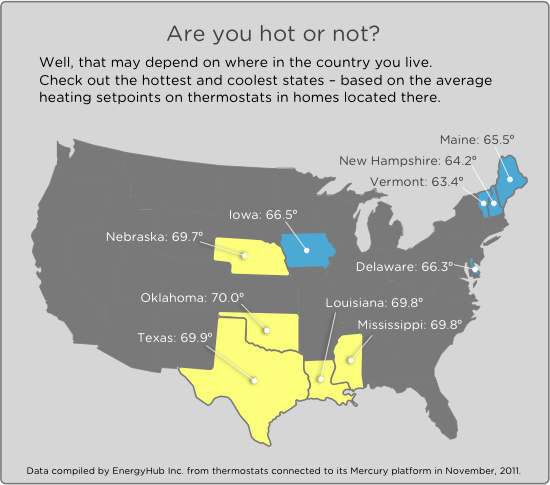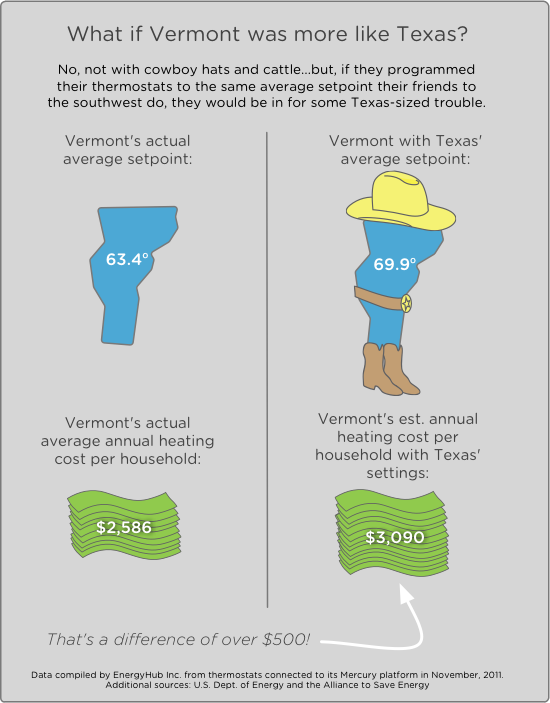
Laura Kier
January 20, 2012
A recent analysis of data compiled through EnergyHub’s MercuryTM smart thermostat platform uncovered a correlation between consumers’ geographic location and the average heating temperature of their homes—with surprising results. Generally, residents in states with cooler average temperatures are setting their thermostats lower than those living in warmer states—from an average of 63.4 degrees Fahrenheit in Vermont to 70.0 degrees in Oklahoma.
With heating season in full effect across the country, we looked at the average Tuesday morning heating temperature (known as the “setpoint”) by state. Since the setpoint is the target temperature which a house’s heating system is working to reach, you might expect similar results across the nation – the thinking being that whether you’re in Maine or Nebraska you have similar comfort preferences. However, the below graphic tells a different story:

We were intrigued by the number of Northern cold-weather states (Vermont, New Hampshire, Maine) on the cool end of the list and the number of Southern ones at the warm end (Oklahoma, Texas, Mississippi, Louisiana). With the help of NOAA’s Climatic Data Center, we plotted the average heating setpoint for each state versus the average number of heating degree days (a measurement designed to reflect the demand for energy to heat a home) per year from 2001-2010. Throw in a regression line—and voila!—there is indeed a nationwide correlation between cold weather and lower heating setpoints.
Though it’s not surprising that residents of cold weather states have higher energy demands to heat their homes than their warm weather counterparts, what is interesting is that the average home heating temperature is lower in the cold areas. This may be proof that Darwin’s core tenet is alive and well—it appears folks in the colder climates have adapted to their surroundings!
Though these findings may seem contradictory, they actually make a great deal of sense. Take Vermont, for example. If Vermonters set their thermostats like Texans, their heating bills would go through the roof. Why? Because Vermont has an average 7,746 heating degree days per year, while Texas has only 1,862.
Just how much are Vermonters saving? Well, by setting their thermostats at 63.4 degrees versus the Texas comfort level of 69.9 degrees, residents are seeing a nearly 20% reduction in their heating costs.1 According to an analysis of Vermont household energy expenditures in 2007, that works out to more than $500 per home per year.

We also thought it helpful to point out that although there is a dramatic difference between the lowest setpoint in Vermont and the highest in Oklahoma, the current ENERGY STAR®-recommended daytime heating setpoint is 70 degrees. So, on average, even the Mercury users from Oklahoma are doing pretty well from an energy-conservation standpoint.
If Texans adopted the same temperature settings as Vermonters, they’d save a mere $42 per year. But the tables turn when summer air-conditioning season comes around—a topic we’ll explore in a future post.
EnergyHub’s Mercury smart thermostat platform collects a wealth of data about how people are actually using their thermostats. The geographic factors we analyzed are just a small sampling of the more than five billion data points generated each month by every 100,000 thermostats on the Mercury platform.
Got a prediction about whether the same pattern will hold during the dead of winter? Which state do you think will have the highest (most-efficient) setpoint during air conditioning season? Have other interesting ideas for analysis? We’d love to hear them. Email us at: ilovedata@energyhub.com.
1Assuming a savings of 3% per degree if the other setpoints for the day were also similarly adjusted. See http://www.energysavers.gov/your_home/space_heating_cooling/index.cfm/mytopic=12720.
Interested in keeping up with the latest dispatch from the grid edge?
Get our next post in your inbox.


